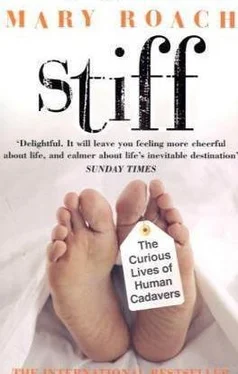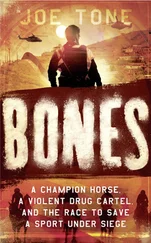When Burke and Hare found out how much money could be made selling corpses, they set about creating some of their own. Several weeks later, a down-and-out alcoholic took ill with fever while staying at Hare’s flophouse. Figuring the man to be well on his way to cadaverdom anyway, the men decided to speed things along. Hare pressed a pillow to the man’s face while Burke laid his considerable body weight on top of him. Knox asked no questions and encouraged the men to come back soon. And they did, some fifteen times. The pair were either too ignorant to realize that the same money could be made digging up graves of the already dead or too lazy to undertake it.
A series of modern-day Burke-and-Hare-type killings took place barely ten years ago, in Barranquilla, Colombia. The case centered on a garbage scavenger named Oscar Rafael Hernandez, who in March 1992 survived an attempt to murder him and sell his corpse to the local medical school as an anatomy lab specimen. [6] With the help of an interpreter, I got the number of an Oscar Rafael Hernandez living in Barranquilla. A woman answered the phone and said that Oscar was not in, whereupon my interpreter gamely asked her if Oscar was a garbage picker, and if he had been almost murdered by thugs who wanted to sell him to a medical school for dissection. A barrage of agitated Spanish ensued, which my interpreter summed up: “It’s the wrong Oscar Rafael Hernandez.”
Like most of Colombia, Barranquilla lacked an organized recycling program, and hundreds of the city’s destitute forge a living picking through garbage dumps for recyclables to sell. So scorned are these people that they—along with other social outcasts such as prostitutes and street urchins—are referred to as “disposables” and have often been murdered by right-wing “social cleansing” squads. As the story goes, guards from Universidad Libre had asked Hernandez if he wanted to come to the campus to collect some garbage, and then bludgeoned him over the head when he arrived. A Los Angeles Times account of the case has Hernandez awakening in a vat of formaldehyde alongside thirty corpses, a colorful if questionable detail omitted from other descriptions of the case. Either way, Hernandez came to and escaped to tell his tale.
Activist Juan Pablo Ordoñez investigated the case and claims that Hernandez was one of at least fourteen Barranquilla indigents murdered for medicine—even though an organized willed body program existed.
According to Ordoñez’s report, the national police had been unloading bodies gleaned from their own, in-house “social cleansing” activities and collecting $150 per corpse from the university coffers. The school’s security staff got wind of the setup and decided to get in on the action. At the time the investigation began, some fifty preserved bodies and body parts of questionable origin were found in the anatomy amphitheater. To date, no one from the university or the police has been arrested.
For his part, William Burke was eventually brought to justice. A crowd of more than 25,000 watched him hang. Hare was granted immunity, much to the disgust of the gallows crowd, who chanted “Burke Hare!”—meaning “Smother Hare,” “burke” having made its way into the popular vernacular as a synonym for “smother.” Hare probably did as much smothering as Burke, but “She’s been hared!” lacks the pleasing Machiavellian fricatives of “She’s been burked!” and the technicality is easily forgiven.
In a lovely sliver of poetic justice, Burke’s corpse was, in keeping with the law of the day, dissected. As the lecture had been about the human brain, it seems unlikely that the body cavity would have been opened and notably rearranged, but perhaps this was thrown in after the fact, as a crowd pleaser. The following day the lab was opened to the public, and some thirty thousand vindicated gawkers filed past. The post-dissection cadaver was, by order of the judge, shipped to the Royal College of Surgeons of Edinburgh to have its bones made into a skeleton, which resides there to this day, along with one of several wallets made from Burke’s skin. [7] Sheena Jones, the secretary at the college who told me about the wallet—which she called a “pocket book,” nearly leading me to write that ladies’ handbags had been made from Burke’s hide—said it had been donated by one George Chiene, now deceased. Mrs. Jones did not know who had made or originally owned the wallet or whether Mr. Chiene had ever kept his money in it, but she observed that it looked like any other brown leather wallet and that “you would not know it is made from human skin.”
Though Knox was never charged for his role in the murders, public sentiment held him accountable. The freshness of the bodies, the fact that one had its head and feet cut off and others had blood oozing from the nose or ears—all of this should have raised the bristly Knox eyebrows.
The anatomist clearly didn’t care. Knox further sullied his reputation by preserving one of Burke and Hare’s more comely corpses, the prostitute Mary Paterson, in a clear glass vat of alcohol in his lab.
When an inquiry by a lay committee into Knox’s role generated no formal action against the doctor, a mob gathered the following day with an effigy of Knox. (The thing must not have looked a great deal like the man, for they felt the need to label if. “Knox, the associate of the infamous Hare,” explained a large sign on its back.) The stuffed Knox was paraded through the streets to the house of the real Knox, where it was hung by its neck from a tree and then cut down and—fittingly—torn to pieces.
It was around this time that Parliament conceded that the anatomy problem had gotten a tad out of hand and convened a committee to brainstorm solutions. While the debate mainly focused on alternate sources of bodies—most notably, unclaimed corpses from hospitals, prisons, and workhouses— some physicians raised an interesting item of debate: Is human dissection really necessary? Can’t anatomy be learned from models, drawings, preserved prosections?
There have been times and places, in history, when the answer to the question “Is human dissection necessary?” was unequivocally yes. Here are some examples of what can happen when you try to figure out how a human body works without actually opening one up. In ancient China, Confucian doctrine considered dissection a defilement of the human body and forbade its practice. This posed a problem for the Father of Chinese Medicine, Huang Ti, who, around 2600 B.C., set out to write an authoritative medical and anatomical text (Nei Ch’ing , or Canon of Medicine) . As is evident from this passage—quoted in Early History of Human Anatomy —there are places where Huang is, through no fault of his own, rather clearly winging it:
The heart is a king, who rules over all organs of the body; the lungs are his executive, who carry out his orders; the liver is his commandant, who keeps up the discipline; the gall bladder, his attorney general… and the spleen, his steward who supervises the five tastes. There are three burning spaces—the thorax, the abdomen and the pelvis—which are together responsible for the sewage system of the body.
To Huang Ti’s credit, though, he managed, without ever disassembling a corpse, to figure out that “the blood of the body is under the control of the heart” and that “the blood current flows in a continuous circle and never stops.” In other words, the man figured out what William Harvey figured out, four thousand years before Harvey and without laying open any family members.
Imperial Rome gives us another nice example of what happens to medicine when the government frowns on human dissection. Galen, one of history’s most revered anatomists, whose texts went unchallenged for centuries, never once dissected a human cadaver. In his post as surgeon to the gladiators, he had a frequent, if piecemeal, window on the human interior in the form of gaping sword wounds and lion claw lacerations.
Читать дальше












